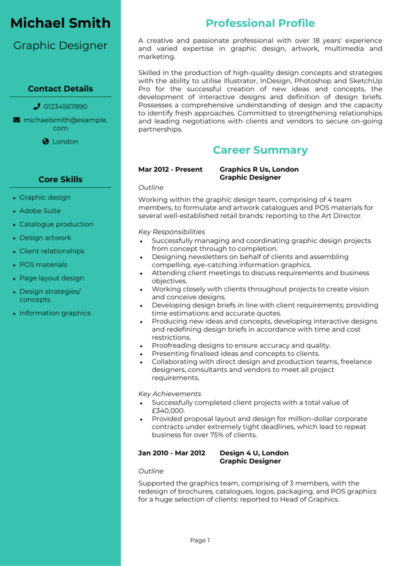As a Graphic Designer, you create the visuals that define brands and user experiences. But before you can wow clients with your creativity, you’ll need to dazzle recruiters with a CV that’s as good as your portfolio.
This guide, packed with Graphic Designer CV examples, will help you craft a CV that demonstrates your technical abilities, creative flair, and professional achievements.
Graphic Designer CV example
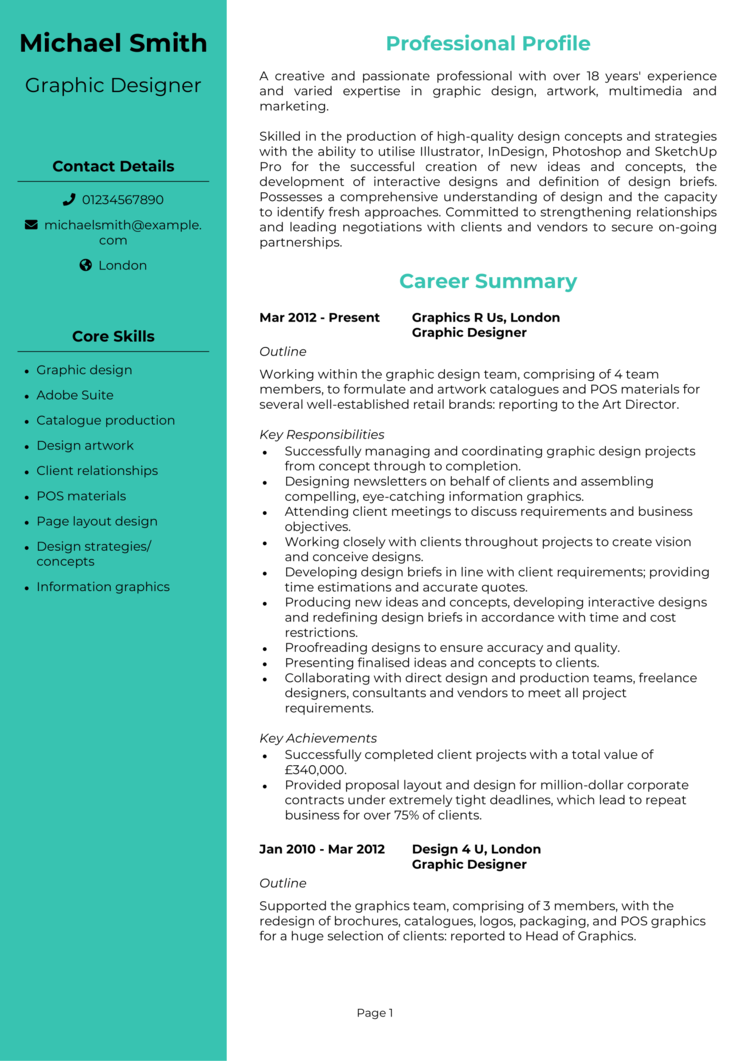
Junior Graphic Designer CV
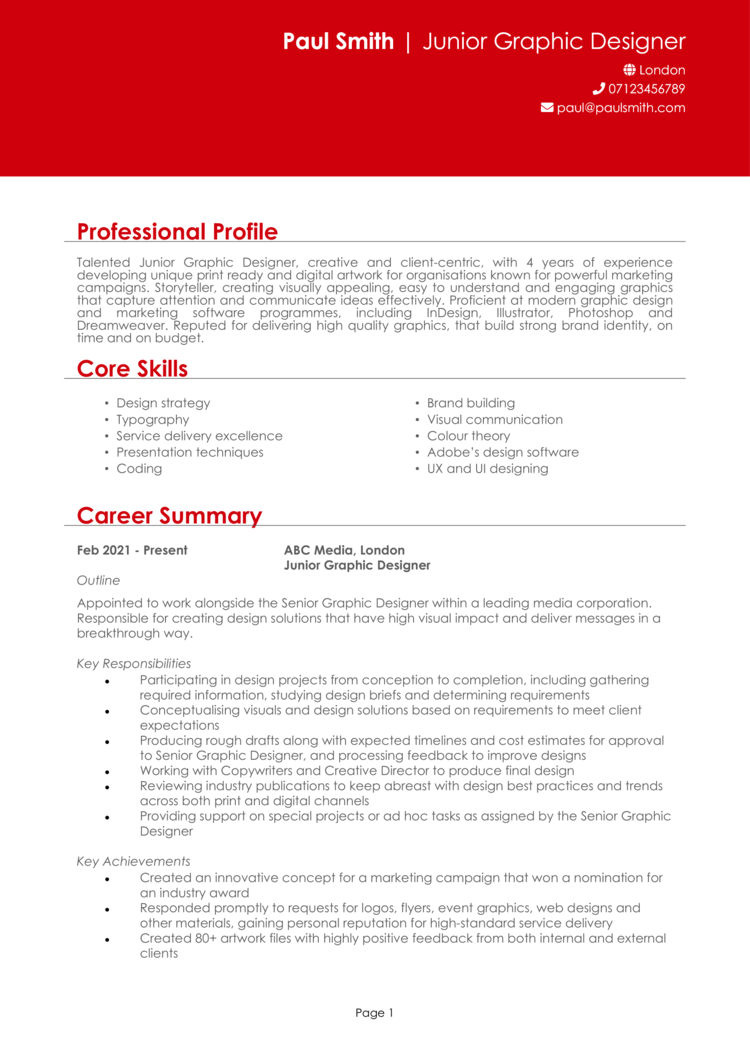
Senior Designer CV example
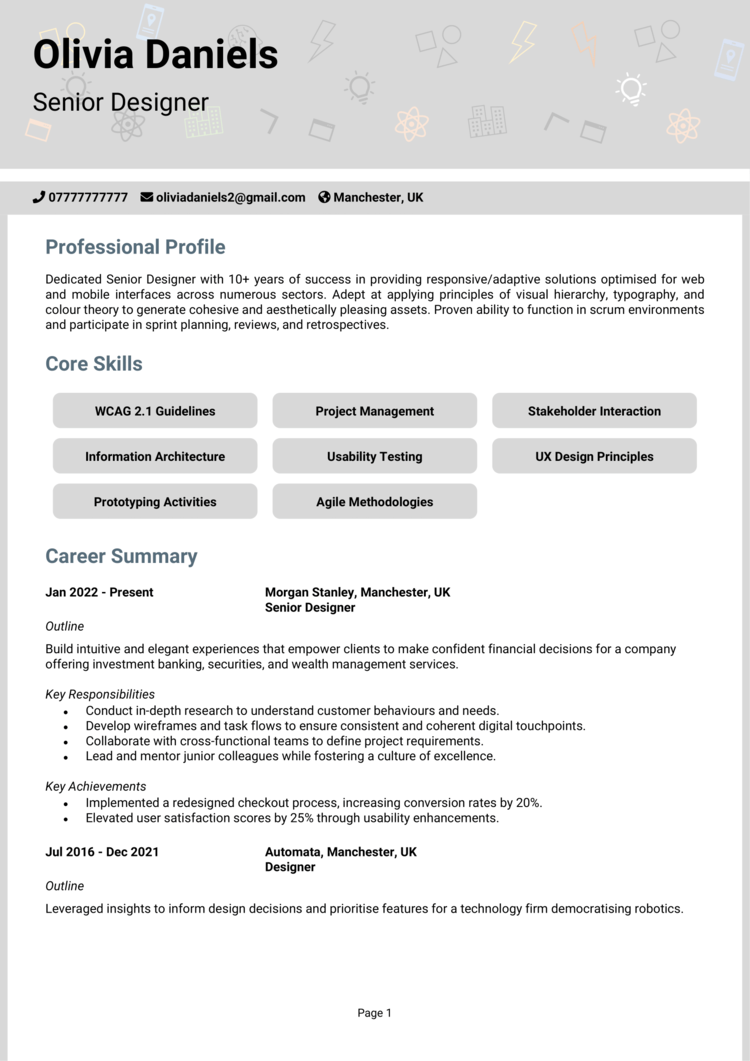
Freelance Graphic Design CV
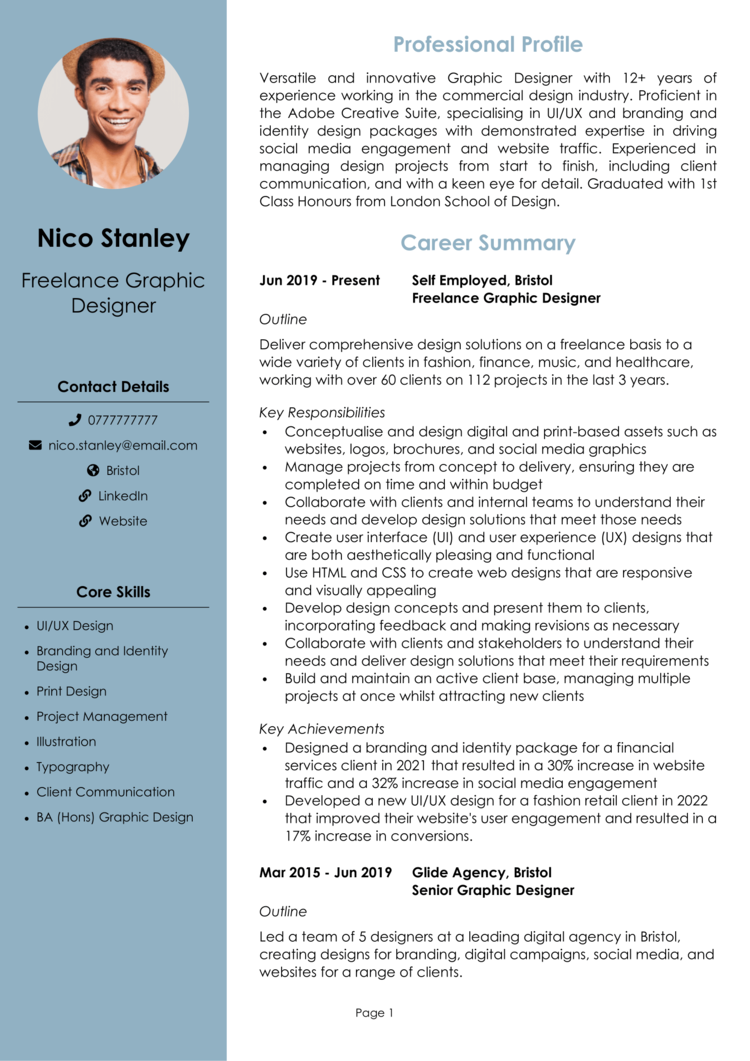
Graphic Design Graduate CV
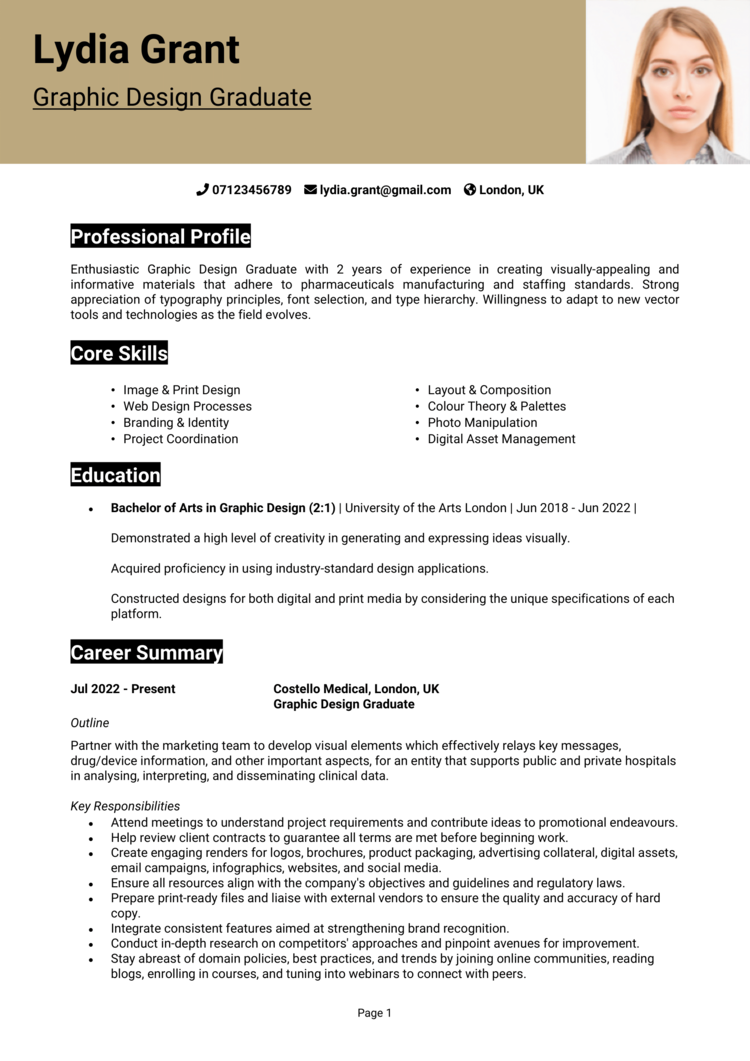
How to write your Graphic Designer CV
Learn how to create your own interview-winning Graphic Designer CV with this simple step-by-step guide.
A Graphic Designer’s CV isn’t just about listing skills – it’s a chance to show off your design sensibility. Think of it as your first project for a potential employer: clear, concise, and visually appealing.
These steps will help you showcase your expertise, highlight your best work, and writing your CV to stand out in a competitive field.
Graphic Designer CV structure


Your Graphic Designer CV needs a structure that’s as well thought out as your most polished design. Recruiters should be able to find the information they need quickly and effortlessly.
Here’s how to structure your Graphic Designer CV:
- Name and contact details – Place your personal details at the top for easy access. Using a photo of yourself is entirely optional.
- Profile – Hook the recruiter with a clear summary of your creative expertise, technical skills, and career highlights.
- Core skills – Highlight abilities like Adobe Creative Suite mastery, branding, and digital design.
- Work experience – Outline your professional work history in reverse chronological order, focusing on major projects and achievements.
- Education – Include academic qualifications, design certifications, and relevant training.
- Additional info – Optionally, mention hobbies and interests that reflect your creativity or design passion.
Graphic Designer CV format


A well-formatted CV is essential for Graphic Designers – it’s your chance to showcase your professionalism and attention to detail. A poorly formatted CV is like Comic Sans – it gets noticed, but not in a good way.
Remember, even the most creative candidates can miss out if their CV has formatting mistakes that distract from their talent.
Here’s how to format your Graphic Designer CV:
- Bullet points – Use these to break up details about projects and achievements to help the recruiter skim through them.
- Divide sections – Clear headings make it easy for recruiters to navigate your CV, making the layout more navigable.
- Use a clean font – Go for a professional, readable font and layout that reflect your design sensibilities.
- Keep it the right length – Make sure it’s no more than 2 pages, ensuring there’s enough space to highlight your skills without overwhelming or boring the reader.
How to create a Graphic Designer CV profile


Your CV profile is like the splash page of your portfolio – make it pop, but keep it professional (no neon gradients, please). It’s a chance to hook the recruiter and show off your creative and technical abilities.
Graphic Designer CV profile examples
Profile 1
Creative Graphic Designer with five years of experience designing digital and print assets for marketing campaigns. Skilled in Adobe Creative Suite, including Photoshop, Illustrator, and InDesign, with a focus on branding, layouts, and typography. Known for delivering visually engaging designs that align with client objectives.
Profile 2
Creative Freelance Graphic Designer with over six years of experience delivering bespoke digital and print designs for clients across various industries, including fashion, tech, and hospitality. Skilled in using Adobe Creative Suite, Figma, and Procreate to create logos, branding materials, and social media content.
Profile 3
Experienced Graphic Designer with over seven years of expertise in corporate branding, web design, and multimedia content creation. Skilled in using tools like Adobe XD and Sketch to produce designs that enhance user experience and drive business results.
What to include in your Graphic Designer CV profile
Here are some tips on what to include in your Graphic Designer CV profile:
- Where you’ve worked – Mention agencies, freelance projects, or in-house roles you’ve held.
- Your top qualifications – Highlight design degrees, certifications, or advanced training.
- Essential skills – Include abilities like typography, UI/UX design, or motion graphics.
- Key projects – Reference standout campaigns, branding projects, or digital designs.
- Design specialisations – Mention any areas of focus, such as web design, print media, or animation.
Core skills section


Your core skills section is a snapshot of your abilities, giving recruiters a quick overview of what you bring to the table.
For Graphic Designers, this should include a mix of technical skills, design expertise, and creative abilities. Tailor this section like you’d tailor a campaign for a picky client: hit all the right notes and leave out the fluff.
Need a graphic designer CV as eye-catching as your portfolio?
Give our CV builder a go: it offers sleek templates, pre-written content for design roles, and pro tips to help you craft a CV that’s as visually strong as your work.
Top skills for your Graphic Designer CV
- Adobe Creative Suite – Proficient in Photoshop, Illustrator, InDesign, and After Effects.
- Branding and Identity – Crafting logos, brand guidelines, and cohesive visual identities.
- Typography – Expertise in type selection, hierarchy, and custom lettering.
- UI/UX Design – Designing intuitive interfaces and enhancing user experiences.
- Illustration – Creating custom artwork for digital and print projects.
- Motion Graphics – Producing engaging animations and video content.
- Print Design – Designing layouts for brochures, posters, and packaging.
- Web Design – Creating responsive websites with attention to functionality and aesthetics.
- Photo Editing – Retouching and manipulating images to meet project needs.
- Creative Problem-Solving – Developing innovative visual solutions for challenging briefs.
Work experience section


Your work experience section is where you demonstrate the impact of your designs and the value you’ve added to previous employers or clients. Highlight major projects, collaborations, and outcomes.
List your roles in reverse chronological order, focusing on key contributions and measurable results.
How should you list jobs on your Graphic Designer CV?

- Outline – Provide an overview of the company, your role, and the types of projects you worked on.
- Responsibilities – Highlight tasks like designing campaigns, collaborating with teams, or managing client briefs. Use action verbs like “created,” “developed,” or “led.”
- Achievements – Showcase results, such as increasing brand engagement, meeting tight deadlines, or receiving design awards. Include numbers wherever possible to add impact.
Example job entries for Graphic Designer
Graphic Designer | Ink Inc.
Outline
Designed digital and print marketing materials for a diverse portfolio of clients, ensuring alignment with brand guidelines and campaign objectives. Collaborated with teams to deliver engaging visual content on tight deadlines.
Responsibilities
- Created logos, brochures, and social media graphics tailored to client specifications.
- Developed website designs using Adobe XD and collaborated with developers for implementation.
- Enhanced brand identities by designing cohesive visual assets across all marketing channels.
- Conducted regular client meetings to gather feedback and refine design concepts.
- Ensured all designs adhered to best practices for accessibility and responsiveness.
Achievements
- Increased client satisfaction by 25 percent through innovative design concepts.
- Delivered 100+ projects on time and within budget over a two-year period.
- Recognised for designing a campaign that boosted client engagement by 30 percent.
Freelance Graphic Designer | Self-Employed
Outline
Delivered custom graphic design solutions for a diverse portfolio of clients, focusing on branding, digital marketing assets, and print materials. Managed the full project lifecycle from conceptualisation to final delivery.
Responsibilities
- Designed logos, business cards, brochures, and social media graphics tailored to individual client needs.
- Developed brand guidelines to ensure visual consistency across all marketing platforms.
- Collaborated with clients through consultations and feedback sessions to refine designs.
- Managed multiple projects with competing deadlines while maintaining high-quality output.
- Used platforms like Canva, Adobe Creative Suite, and Figma to produce engaging designs.
Achievements
- Increased client satisfaction rates by 30 percent by implementing a structured feedback process.
- Completed over 50 successful branding projects for small businesses and startups.
- Generated repeat business from 80 percent of clients due to quality designs and timely delivery.
Graphic Designer | Inspiring Brands Co.
Outline
Developed branding and visual identities for startups and small businesses, ensuring professional and impactful representation. Delivered end-to-end design solutions tailored to client needs.
Responsibilities
- Created brand guidelines, including logos, colour palettes, and typography standards.
- Designed marketing materials such as business cards, presentations, and packaging.
- Developed website layouts and wireframes for client approval.
- Worked closely with clients to understand their vision and translate it into compelling designs.
- Provided post-project support, including design tweaks and file preparation for print.
Achievements
- Increased client referrals by 35 percent through high-quality branding work.
- Completed 20+ branding projects in one year, exceeding client expectations.
- Recognised for developing a logo design that won a regional small business award.
Highlighting your education


The education section is where you highlight your foundational training in design. Include degrees, certifications, and relevant courses that demonstrate your expertise.
List your qualifications in reverse chronological order, starting with the most recent.
Best qualifications for Graphic Designers
- Bachelor’s Degree in Graphic Design – Comprehensive training in design principles and software.
- Adobe Certified Expert (ACE) – Certification in advanced Adobe Creative Suite skills.
- UI/UX Design Specialisation – Training in interface design and user experience.
- Motion Graphics Certification – Expertise in creating animations and video effects.
- Web Design Certification – Proficiency in responsive and mobile-friendly design.


